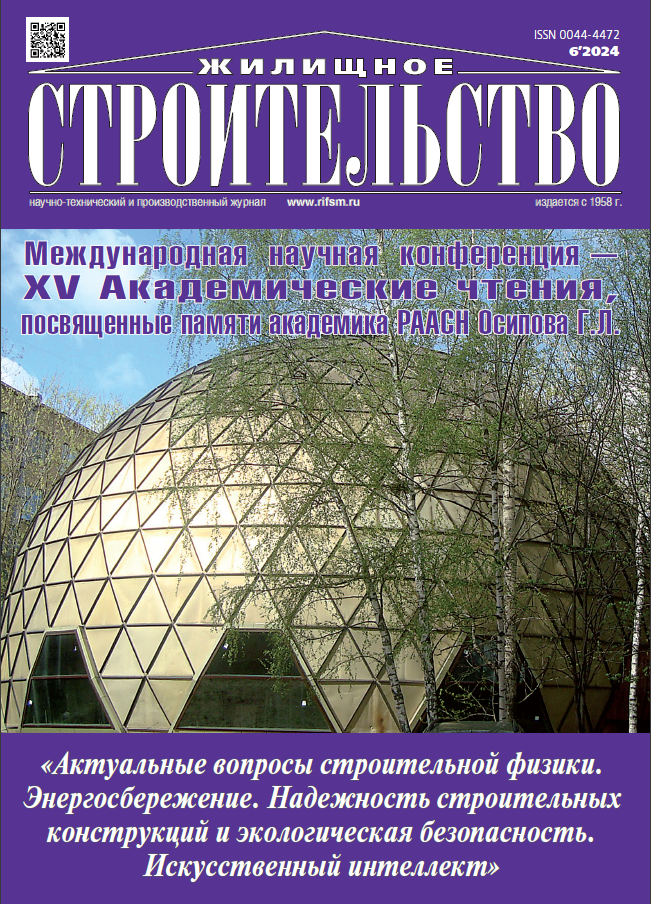Антирейтинг конструктивных решений полов по изоляции ударного шума
- Авторы: Крышов С.И.1, Котельников Д.Е.1, Градова О.В.2
-
Учреждения:
- Центр экспертиз, исследований и испытаний в строительстве
- Научно-исследовательский институт строительной физики РААСН
- Выпуск: № 6 (2024)
- Страницы: 21-24
- Раздел: СТАТЬИ
- URL: https://modernonco.orscience.ru/0044-4472/article/view/634819
- DOI: https://doi.org/10.31659/0044-4472-2024-6-21-24
- ID: 634819
Цитировать
Полный текст
Аннотация
Одной из важных характеристик комфортной среды для повседневного пребывания человека является звукоизоляция ограждающих конструкций. Недостаточные показатели звукоизоляционных свойств ограждающих конструкций оказывают негативное влияние на здоровье и трудовую деятельность человека. В значительной степени как на физическое, так и на психологическое состояние организма влияет уровень ударного шума. С целью оценки этих показателей проведены множественные испытания различных конструкций перекрытий на соответствие индекса приведенного уровня ударного шума действующим нормативным требованиям. Рассмотрены различные варианты конструктивных решений перекрытий между помещениями в зданиях различного назначения, показавших наихудшие значения индексов приведенного уровня ударного шума. Проведен анализ решений и исследований, представленных в различных справочных и научных материалах и публикациях прошлых лет. Проанализирована зависимость индексов приведенного уровня ударного шума перекрытий от применяемых конструктивных решений и условий испытаний. Подробно описан состав слоев конструкции полов согласно информации, представленной в проектной и рабочей документации по каждому объекту исследования. Даны графики взаимного положения частотных характеристик и оценочных спектров приведенного уровня ударного шума под перекрытием для каждой рассматриваемой конструкции.
Ключевые слова
Полный текст
Об авторах
С. И. Крышов
Центр экспертиз, исследований и испытаний в строительстве
Автор, ответственный за переписку.
Email: skryshov@yandex.ru
канд. техн. наук, начальник отдела
Россия, 109052, г. Москва, Рязанский пр-т, 13Д. Е. Котельников
Центр экспертиз, исследований и испытаний в строительстве
Email: yorik487@yandex.ru
ведущий инженер
Россия, 109052, г. Москва, Рязанский пр-т, 13О. В. Градова
Научно-исследовательский институт строительной физики РААСН
Email: mail@rifsm.ru
руководитель сектора № 42.1 «Акустические материалы и конструкции»
Россия, 127238, г. Москва, Локомотивный пр., 21Список литературы
- Новосельцев Ю.П., Чумасова Е.В., Шалагинова Е.В. Звукоизоляция межквартирных перегородок и межэтажных перекрытий в жилых зданиях. Общество. Наука. Инновации (НПК-2018): Сборник статей XVIII Всероссийской научно-практической конференции: В 3 т. Вятский государственный университет. 2018. С. 629–635.
- Крышов С.И. Проблемы звукоизоляции строящихся зданий // Жилищное строительство. 2017. № 6. С. 8–10.
- Редько Ю.Б. Измерения изоляции ударного шума внутренними ограждающими конструкциями (перекрытиями) в натуральных условиях // Кровельные и изоляционные материалы. 2013. № 2. С. 24–27.
- Крышов С.И., Котельников Д.Е., Градова О.В. Зависимость изоляции ударного шума от состава конструктивных слоев напольного покрытия // БСТ: Бюллетень строительной техники. 2021. № 6 (1042). С. 16–17.
- Шнурникова Е.П., Азарова С.А. Звукоизоляция ударного шума перекрытиями с рулонными полами // Научные труды КубГТУ. 2021. № 4. С. 18–25.
- Пороженко М.А. Изоляция ударного шума ограждающими конструкциями здания // БСТ: Бюллетень строительной техники. 2018. № 6. С. 34–35.
- Орлов О.Г. Пути решения проблемы защиты жилых помещений от ударных источников шума. Традиции и инновации в строительстве и архитектуре. Естественные науки и техносферная безопасность: Сборник статей по материалам 72-й Всероссийской научно-технической конференции. Самарский государственный архитектурно-строительный университет. 2015. С. 368–370.
- Кормилицын В.И., Ганиев С.Р., Пустовгар А.П. Разработка новых строительных материалов с повышенными совмещенными свойствами изоляции ударного шума междуэтажных перекрытий. Защита населения от повышенного шумового воздействия: Сборник докладов Всероссийской научно-практической конференции с международным участием / Под ред. Н.И. Иванова, К.Б. Фридмана. 2015. С. 283–285.
- Сенан А.М. Оценка изоляции ударного шума конструкциями междуэтажных перекрытий с прокладочными материалами из песка. Защита населения от повышенного шумового воздействия: Сборник докладов Всероссийской научно-практической конференции с международным участием / Под ред. Н.И. Иванова, К.Б. Фридмана. 2015. С. 274–275.
- Шубин И.Л. Нормативные документы по энергосбережению и строительной акустике, разработанные НИИСФ РААСН // БСТ: Бюллетень строительной техники. 2012. № 2. С. 7–13.
Дополнительные файлы

















